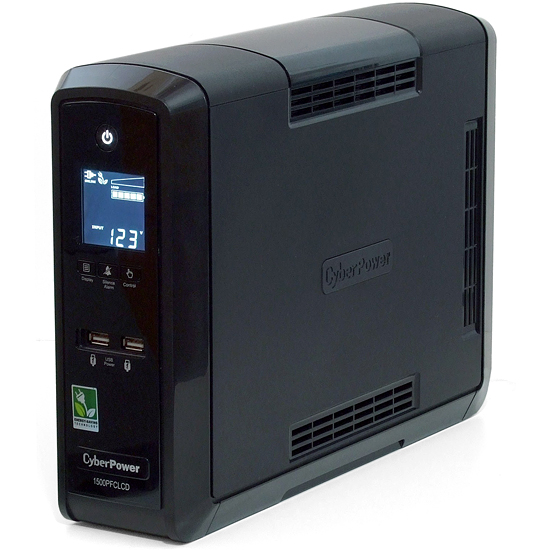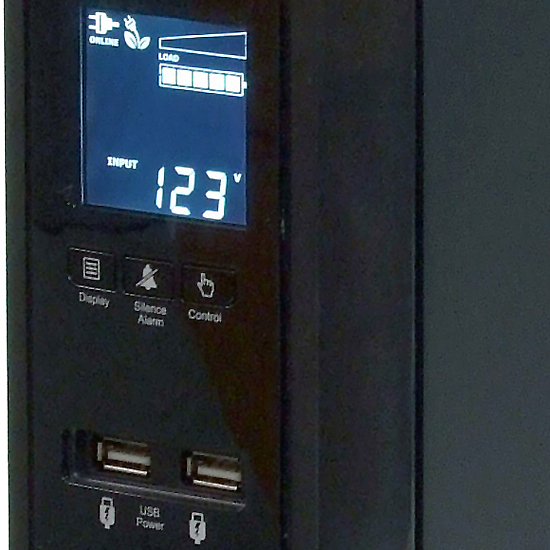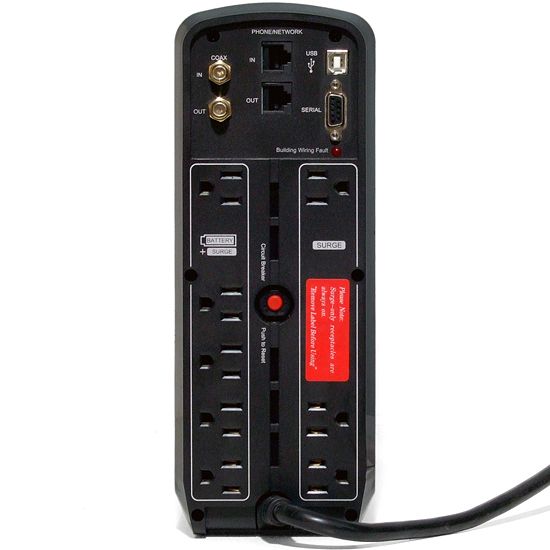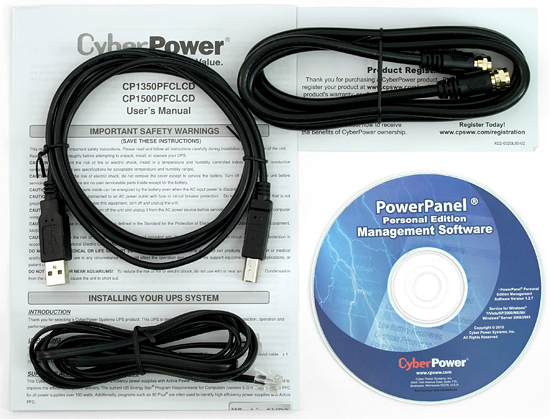Enthusiast Power Protection: Four-Way 900 W UPS Roundup
It's downright negligent to ignore the power needs of your high-end hardware. While many power users go to the trouble of tracking down solid PSUs, we recommend going a step further and investing in battery backup. We round up four enthusiast units.
CyberPower CP1500PFCLCD
The long name for CyberPower’s upper-mainstream backup unit is easily broken down into brand (CP), VA rating (1500), PFC power supply support, and an LCD front-panel display.
Besides being the smallest, lightest, and cheapest unit in today’s roundup, the CP1500PFCLCD is also the only unit that has not fully replaced step-wave with pure-sine-wave circuitry, instead opting for a modified triangular wave that CyberPower calls “Adaptive Sinewave” to eliminate the zero power state that has so often prevented step-wave units from working with active PFC power supplies. This basically means that users get the enhanced compatibility of a sine wave unit at a low price similar to many step wave competitors.
A large LCD panel eases manual configuration from the unit itself, giving users one more excuse not to install the included management software. Enhanced front-panel capabilities also make the CP1500PFCLCD a better choice for non-PC power backup applications, such as home theater system protection, and CyberPower even lets you charge your USB-equipped cell phone from the front panel. If you’re starting to think this might be the perfect device for household emergencies, that’s probably the kind of thinking CyberPower is hoping to foster.
Unlike more expensive solutions that have configurable load-shedding outlets, the CP1500PFCLCD has five battery-backed and five surge-only outlets (two covered by the red warning label). PC users can plug unneeded peripherals like their speakers and printer to the surge-only connections for instant power-off, preserving the battery for their PC and monitor. Similarly, home-theater users can keep required devices, such as their TV, cable box, and radio plugged into the battery-backed side as they listen to emergency alerts, while unnecessary devices power off instantly to preserve the unit's limited battery life.
CyberPower surprised us by including a telephone and TV cables in its installation kit, along with the expected USB cable, manual, and software CD.
Get Tom's Hardware's best news and in-depth reviews, straight to your inbox.
Current page: CyberPower CP1500PFCLCD
Prev Page SMT1500 Management Software Next Page CP1500PFCLCD Management Software-
sudeshc Have been using APC for last 2 years now without any issues what so ever.Reply
Would recommend it although they might be a bit costly but they perform really well. -
hmp_goose Soooo you have nothing to say about the TripLite atoll? Dead last? Distant second? Muddled mess? Nice part for not-our-application?Reply -
dEAne I have several units of APC and a hundred after-sales issues which remains unanswered, I opted to installed the generator set and a AVR than a UPS.Reply -
Emperus Most folks would just be happy to ignore on the need for a backup power source.. Hope this article enlightens them on getting one to protect their precious components and/or be ready if and when the situation arises.. Would be great if Tom's could put up a tier based classification on suitable UPS choices for various PC's (gaming, server, home theatre etc.)..Reply -
super_tycoon What about AVR? (Automatic Voltage Regulation) I have a CP1500AVRLCD and I've seen (at least I'm pretty sure) I've seen the AVR feature kick in when one of the local power lines got knocked out and the voltage drooped to ~100. (killed some of my non-dimmable cfl's) I went to CP's website and it claimed the pfc units still have AVR functionality. So here comes the confusion, what's the point of the voltage tolerances? If it has an AVR, why would it matter what voltage it's fed as long as there steps on the transformer? I thought the unit was supposed to take 90-140 without having to engage the battery while still passing ~120v?Reply
You've also made me want to test my non-pfc ups with my 850hx, but my gaming rig and my workstation are an hour apart.... -
aldaia This is a quite inefficient & expensive approach to the problem. We take AC and use a transformer to convert to DC and store in a battery, meanwhile another transformer is also taking AC and converting to DC to feed our components. When there is a blackout, we take DC from the battery, convert to AC and feed the computer PS where we convert back to DC to feed our components. Wouldn't be more cost effective and energy efficient to use the same unit to both feed our components with DC and the battery? Most of the time a PS has a surplus of power that can be used to charge the battery. When there is a blackout we could just take DC from battery and feed our components without the inefficient double DC->AC->DC conversion. I think an integrated UPS/PS would be cheaper (most components are replicated). That would be enough for most enthusiasts, that only need a relatively short battery life to be able to save work. A different matter is in professional environments where a UPS feeds dozens of computers that cannot be stopped. ¿Anyone knows if such a think exists?Reply -
wrxchris I've been using a CyberPower 1350AVR for the past couple years and it has been great. Gives me approx. 17 mins of runtime at idle / basic tasks (approx. 250 watts between my rig and main LCD). It's good for 810W, and I believe I picked it up on sale for $120.Reply -
g00ey I've always been wondering about the possibilities to replace the small batteries in those UPSes with standard car batteries or deep cycle (marine) batteries. Since the batteries in the UPSes are standard 12V lead cells it shouldn't be a problem and this would be a cheap way to keep the computer alive for days without external power.Reply -
nebun g00eyI've always been wondering about the possibilities to replace the small batteries in those UPSes with standard car batteries or deep cycle (marine) batteries. Since the batteries in the UPSes are standard 12V lead cells it shouldn't be a problem and this would be a cheap way to keep the computer alive for days without external power.wrongReply




